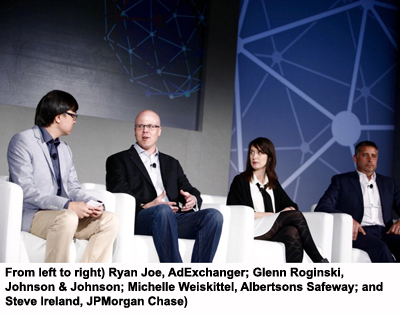 The irony of digital marketing is that it has to justify itself because it can justify itself.
The irony of digital marketing is that it has to justify itself because it can justify itself.
If Michelle Weiskittel, manager of digital marketing at Albertsons Safeway, wants to get the budget to do her job, she must demonstrate as clear a connection as possible between online campaigns and actual sales.
Print doesn’t carry that burden and, to a large extent, neither does TV, at least for now.
“Actual paper circulars that go out are core to our business and no one really questions whether that just goes in the trash can, but I have to prove out my incrementality and sales,” Weiskittel said Thursday at AdExchanger’s PROGRAMMATIC.IO in San Francisco. “Granted, we in the digital world created this and we kind of thrive on it.”
The ultimate goal of every digital marketing effort at Safeway is incremental offline store visits. Proving the connection isn’t necessarily easy.
Partially, that’s because “we’re not dealing with pure-play acquisition,” Weiskittel said. “Everyone’s been into a grocery store – but am I going to get that incremental sale for that day or that week?”
It’s the difference between shoes and, say, margarine. If a department store knows someone loves shoes or even a particular brand of shoes, that person goes right into the “shoe lover” segment. The next time there’s a sale on Manolo Blahniks and this person comes in after being exposed to online advertising, it’s relatively easy to determine the incremental visit.
But there’s no such thing as a margarine segment and most people go to the grocery store on a weekly basis or even more frequently, regardless of a sale for any particular item.
“What we look at is understanding our customer base and what they’re shopping at sort of broad levels to make sure that we’re categorizing them in the right way and try to get that incrementality in the store,” Weiskittel said.
Safeway does, however, have access to transactional data through its point-of-sale system.
The landscape is a little different for pharma marketers, but the goal is the same. The pharmaceuticals division of Johnson & Johnson, for example, works with health care data analytics company Crossix to power its targeting and measurement of offline conversions.
 Crossix aggregates deidentified data from health care data distributors and individual companies, including United Healthcare, and then partners with Acxiom to create targeting pixels and lookalike audiences. Behind the scenes, Crossix can tie the pixel back to an actual prescription.
Crossix aggregates deidentified data from health care data distributors and individual companies, including United Healthcare, and then partners with Acxiom to create targeting pixels and lookalike audiences. Behind the scenes, Crossix can tie the pixel back to an actual prescription.
But making that data actionable is far from a real-time process and it probably won’t ever be one, at least in the pharma space, said Glenn Roginski, director of media and connections for pharmaceuticals at Johnson & Johnson.
“If it’s an ROI measure, right now it’s been sort of twice-a-year reads,” Roginski said. “If it’s things like brand awareness, lift, intent lift – with companies like a comScore or a Millward Brown, it takes time to build a survey until you get to a statistically significant sample.”
And because many of Johnson & Johnson’s targets, at least in the pharma space, are centered on categories where the sufferer population may be quite small, it might even take the entirety of a particular campaign to reach enough impressions, let alone generate real-time insights.
But for JPMorgan Chase, the real-time piece is “an imperative,” said Steve Ireland, the brand’s SVP and managing director of digital channel marketing.
When customers are “coming to us, they’re looking for us to reflect what we know about them,” Ireland said. “And if we miss, we look stupid. And if we look stupid, we look like we’re not connected. And if we look like we’re not connected, we lose that customer and we lose the chance to talk to them again.”













